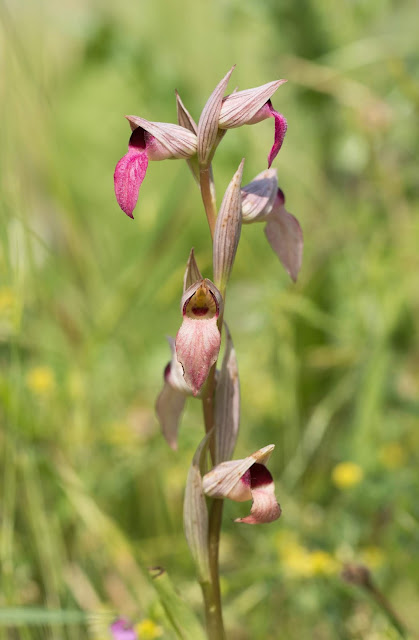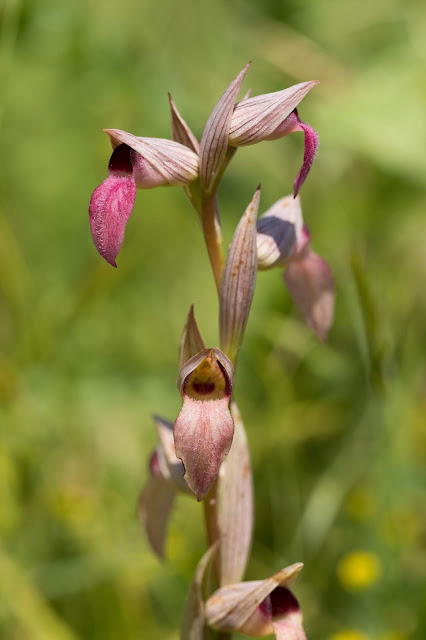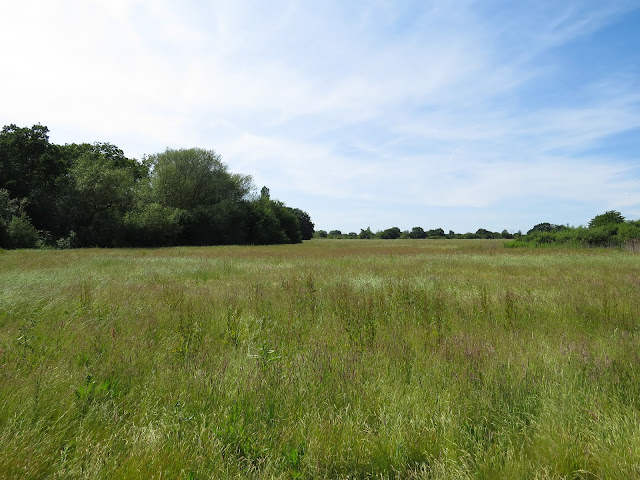When a colony of Greater Tongue Orchids was discovered in Essex during the summer of 2017, the race was on to track the plants down and establish whether they were naturally occurring or had arrived artificially. With just a single photo of several flowering spikes in a field to go on (which was hastily removed from the Facebook page to which it was posted) several of the orchid world's enthusiasts expertly narrowed down the location, and by carefully checking the vegetation on site to that in the photo, were remarkably able to pin down the exact spot where these exotic orchids were growing.



Sadly, by the time they were
found all but a very small handful of the plants had completely gone over, and
as such, arrangements were kindly made for a number of organised visits last summer so those interested could admire these Mediterranean beauties in all
their glory.
Therefore, at the beginning of
June last year, me and my Dad made the long journey down to Essex and were met on site by
local resident Jonathan who showed us the exact location in the meadows where
this small cluster of orchids were growing, thankfully in prime condition
despite the scorching sun and allowing for excellent photographic opportunities
(despite some tripod issues!).
With around 36 plants in flower last year, the
number was slightly down on 2017's showing, but luckily each delicate maroon flowering spike
was in top condition (I had actually been away in America the previous week so
was a bit concerned the flowers may have been past their best by the time I got there) and the colony
had been carefully marked out with several small canes to prevent trampling by
unaware dog walkers.
With orchid seed being
particularly fine and easily carried by the wind, there is of course every
possibility that seed from the continent had blown over naturally, with the
nearest populations occurring in France, Spain and Italy. However, a number of
other circumstances need to be considered before determining whether these
continental plants really did make it over here without a little bit of human
help.
A single specimen could easily have been planted out by a keen botanist or gardener many years
ago, reproducing year on year to result in the small colony seen now (the
plants were all restricted to a tiny area about a metre squared in size and
found nowhere else on the meadows as you would expect from plants in a natural continental setting). Likewise, seed blown artificially from plants growing in a pot in a nearby garden could have easily kick started a colony.
However, this would be an odd site for a deliberate planting, and no pot grown specimens are growing nearby to our knowledge - even if they were, the Greater Tongue Orchids natural pollinator is not known to occur in Britain, making seed set very unlikely without assistance.
Upon talking to Jonathan, he explained that decades ago the meadows were used as strawberry fields alongside a plant nursery that amongst other things was known to grow tropical orchids. This therefore creates an entirely feasible scenario of Tongue Orchid seed being accidentally imported - getting in to the mix of soil, clippings and cuttings discarded on site and germinating, eventually becoming established and naturalised - in my opinion the most likely origin.
However, this would be an odd site for a deliberate planting, and no pot grown specimens are growing nearby to our knowledge - even if they were, the Greater Tongue Orchids natural pollinator is not known to occur in Britain, making seed set very unlikely without assistance.
Upon talking to Jonathan, he explained that decades ago the meadows were used as strawberry fields alongside a plant nursery that amongst other things was known to grow tropical orchids. This therefore creates an entirely feasible scenario of Tongue Orchid seed being accidentally imported - getting in to the mix of soil, clippings and cuttings discarded on site and germinating, eventually becoming established and naturalised - in my opinion the most likely origin.
This is not the first
occurrence of Greater Tongue Orchid in the UK however, with a small well-known colony of
Greater Tongue Orchids situated at Wakehurst Place in Sussex alongside the
introduced Loose-flowered Orchids (never proven but very unlikely to be of natural
origin as a consequence). Three flower spikes were also discovered near to the coast in Kingsbridge, south Devon back in 1998, but once again, their origins were never proven - some suspecting seed had come from an artificial source such as a nearby plant collection or agricultural seed mix.
Small-flowered Tongue Orchids have also previously gotten a very shallow toehold on British soil in the past with individuals cropping up near Rame Head in SE Cornwall, having first been discovered there in 1989, but sadly disappearing in the early 2000s. With seed suspected to have blown in from the continent as opposed to a deliberate planting due to the remote location, it's entirely probable these were the result of natural colonisation from across the channel.
 |
| The Tongue Orchids have reproduced vegetatively to cover a small patch of ground in the meadow |
 |
| Spot the Tongue Orchid! The small patch where the orchids were growing |
 |
| The meadow in Tiptree, Essex where the Greater Tongue Orchids were found |















